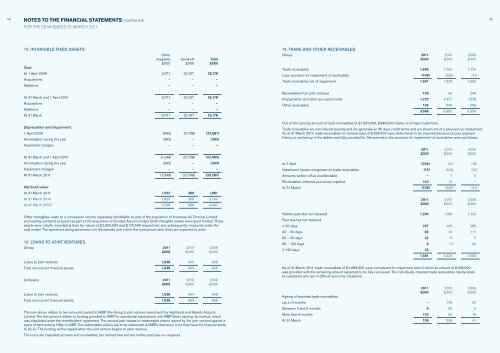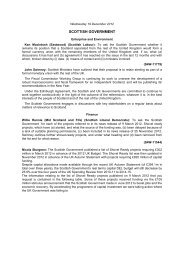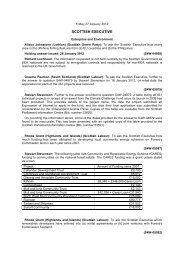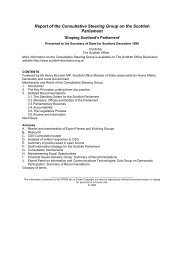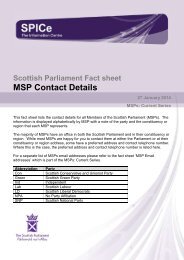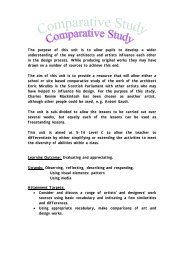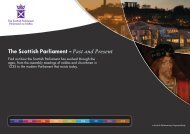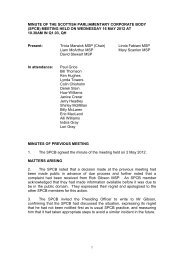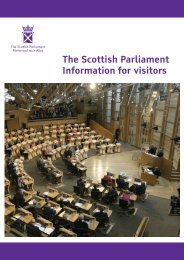Highlands and Islands Airport's Annual Report (3MB pdf - Scottish ...
Highlands and Islands Airport's Annual Report (3MB pdf - Scottish ...
Highlands and Islands Airport's Annual Report (3MB pdf - Scottish ...
Create successful ePaper yourself
Turn your PDF publications into a flip-book with our unique Google optimized e-Paper software.
22<br />
DIRECTORS’ REPORT (CONTINUED)<br />
GOING CONCERN<br />
The parent company sets an annual<br />
budget which aims to balance income,<br />
expenditure <strong>and</strong> operating subsidy<br />
provisions set by government. Future<br />
operational <strong>and</strong> legislative requirements<br />
are addressed in a ten year corporate<br />
plan which includes provision for revenue<br />
<strong>and</strong> capital items such as major repairs<br />
to runways or new or replacement<br />
equipment. The operating subsidy<br />
provisions for the year to 31 March 2011<br />
were set at £25.1 million (including<br />
£18.1 million of revenue subsidy) <strong>and</strong><br />
this was drawn down during the year.<br />
The operating subsidy provisions have<br />
been set at £26.6 million (including<br />
£17.9m of revenue subsidy) for the year<br />
ending 31 March 2012. This is considered<br />
by the directors to be adequate to sustain<br />
the Group as a going concern having<br />
considered the 12 months ahead from<br />
date of approval.<br />
PRINCIPAL RISKS AND<br />
UNCERTAINTIES<br />
The Group has an established risk<br />
committee, the Risk Oversight Group. The<br />
managing director, senior managers <strong>and</strong><br />
appropriate line managers are responsible<br />
for the effective management of risk within<br />
the company <strong>and</strong> ensure that appropriate<br />
procedures, resources <strong>and</strong> skills are<br />
introduced <strong>and</strong> maintained to achieve this.<br />
The principal risks <strong>and</strong> uncertainties facing<br />
the Group are broadly grouped as liquidity,<br />
competitive <strong>and</strong> legislative.<br />
• Liquidity risks<br />
The Group manages liquidity risk<br />
by maintaining adequate reserves<br />
<strong>and</strong> banking facilities <strong>and</strong> continually<br />
monitoring forecast <strong>and</strong> actual<br />
cash flows.<br />
• Competitive risks<br />
The income for the Group is derived<br />
from a limited number of airline<br />
customers. Any external pressures<br />
faced by those customers may lead to<br />
them reviewing their operating schedule<br />
<strong>and</strong> this in turn may impact on Group<br />
income <strong>and</strong> costs.<br />
• Legislative risks<br />
Airport operations across the Group<br />
are regulated by the Health <strong>and</strong> Safety<br />
Executive, UK Civil Aviation Authority<br />
<strong>and</strong> security st<strong>and</strong>ards are set by the<br />
Department for Transport. These bodies<br />
regularly review <strong>and</strong> update their<br />
st<strong>and</strong>ards <strong>and</strong> requirements <strong>and</strong><br />
any new Directives are likely to have<br />
a material impact on the cost of<br />
airport operations.<br />
• Operational risks<br />
The Group manages operational risk<br />
through its safety management <strong>and</strong><br />
risk management systems.<br />
Overall Group strategy <strong>and</strong> direction is<br />
determined by the board of directors<br />
<strong>and</strong> by <strong>Scottish</strong> Government policy. In<br />
mitigation of the risks identified above,<br />
the <strong>Scottish</strong> Government has committed<br />
to providing £26.6 million for the financial<br />
year 2011/12 <strong>and</strong> this may be amended<br />
due to operational circumstances <strong>and</strong> by<br />
agreement with the <strong>Scottish</strong> Government<br />
<strong>and</strong> the Group. As outlined in the going<br />
concern statement above, this is<br />
considered by the directors to be<br />
adequate to sustain the Group as<br />
a going concern.<br />
AUDITORS<br />
The auditors, Ernst & Young LLP,<br />
will be proposed for reappointment<br />
in accordance with section 485 of<br />
the Companies Act 2006.<br />
DIRECTORS<br />
The Directors who served during the year<br />
to 31 March 2011 <strong>and</strong> subsequently are:–<br />
Grenville Johnston Chairman<br />
Inglis Lyon Managing Director<br />
Michael Cantlay Director<br />
Andrew Castell Director<br />
Alistair Goodlad Director<br />
Linn Phipps Director<br />
Alan Shaw Director<br />
Resigned 18 June 2010<br />
DIRECTORS’ QUALIFYING<br />
THIRD PARTY INDEMNITY<br />
PROVISIONS<br />
The directors have the benefit of the<br />
indemnity provisions contained in the<br />
company's Articles of Association.<br />
This provision, which is a qualifying third<br />
party indemnity provision as defined by<br />
the Companies Act 2006, was in force<br />
throughout the financial year <strong>and</strong> is<br />
currently in force. The parent company<br />
also purchased <strong>and</strong> maintained throughout<br />
the financial year liability insurance for<br />
its directors.<br />
DIRECTORS’ STATEMENT<br />
AS TO DISCLOSURE OF<br />
INFORMATION TO AUDITORS<br />
The directors who were members of<br />
the board at the time of approving the<br />
Directors’ report are listed on page 1.<br />
Having made enquiries of fellow Directors<br />
<strong>and</strong> of the Group’s auditors, each of<br />
these directors confirms that:–<br />
• to the best of each director’s<br />
knowledge <strong>and</strong> belief, there is no<br />
information relevant to the preparation<br />
of their report of which the Group’s<br />
auditors are unaware; <strong>and</strong><br />
• each director has taken all the steps a<br />
director might reasonably be expected<br />
to have taken to be aware of relevant<br />
audit information <strong>and</strong> to establish that<br />
the Group’s auditors are aware of<br />
that information.<br />
By order of the Board<br />
Norman Ross CA<br />
Company Secretary<br />
29 July 2011<br />
STATEMENT ON INTERNAL CONTROL<br />
SCOPE OF RESPONSIBILITY<br />
As accountable officer I have responsibility<br />
for maintaining a system of internal control<br />
that supports the achievement of the<br />
company’s aims, objectives <strong>and</strong> policies<br />
agreed between the board <strong>and</strong> the<br />
<strong>Scottish</strong> Ministers, whilst safeguarding<br />
the public funds <strong>and</strong> assets for which<br />
I am responsible.<br />
The <strong>Scottish</strong> Public Finance Manual<br />
(SPFM) is issued by the <strong>Scottish</strong> Ministers<br />
to provide guidance to the <strong>Scottish</strong><br />
Government <strong>and</strong> other relevant bodies<br />
on the proper h<strong>and</strong>ling of public funds.<br />
It is designed to ensure compliance with<br />
statutory <strong>and</strong> parliamentary requirements,<br />
promote value for money <strong>and</strong> high<br />
st<strong>and</strong>ards of probity <strong>and</strong> secure effective<br />
accountability <strong>and</strong> good systems of<br />
internal control. As the company is<br />
a body sponsored by the <strong>Scottish</strong><br />
Government, guidance contained<br />
in the SPFM is applicable.<br />
PURPOSE OF THE SYSTEM<br />
OF INTERNAL CONTROL<br />
The system of internal control is designed<br />
to mitigate rather than eliminate the risk of<br />
failure to achieve the company’s policies,<br />
aims <strong>and</strong> objectives. It can therefore only<br />
provide reasonable <strong>and</strong> not absolute<br />
assurance of effectiveness.<br />
The system of internal control is an active<br />
process designed to identify the principal<br />
risks to the achievement of the company’s<br />
aims, objectives <strong>and</strong> policies, to evaluate<br />
the nature <strong>and</strong> extent of those risks <strong>and</strong><br />
to manage them efficiently, effectively<br />
<strong>and</strong> economically.<br />
The process within the organisation<br />
accords with the SPFM <strong>and</strong> has been in<br />
place for the year ended 31 March 2011<br />
<strong>and</strong> up to the date of approval of the<br />
annual report <strong>and</strong> accounts.<br />
RISK AND CONTROL<br />
FRAMEWORK<br />
All bodies subject to the requirements of<br />
the SPFM must operate a risk management<br />
strategy in accordance with relevant<br />
guidance issued by the <strong>Scottish</strong> Ministers.<br />
The general principles for a successful risk<br />
management strategy are set out in the<br />
SPFM. All areas of company risk are<br />
managed through the Risk Oversight<br />
Group <strong>and</strong> the senior management team<br />
who report to the boards of HIAL, DAL<br />
<strong>and</strong> AMSL (the Group).<br />
Risk management<br />
The managing director <strong>and</strong> through him<br />
the Board is responsible for the overall<br />
risk management of the business however<br />
responsibility for specific risk management<br />
areas has been delegated to individual<br />
directors <strong>and</strong> managers.<br />
The terms of reference for the Risk<br />
Oversight Group are as follows:–<br />
• Identify new <strong>and</strong> emerging risks<br />
(including opportunities) facing<br />
the Group <strong>and</strong> its operations;<br />
• Ensure significant risks are being<br />
effectively managed across the<br />
business by reviewing the Group risk<br />
register <strong>and</strong> updating as necessary,<br />
giving consideration to the Group’s<br />
risk exposure;<br />
• Coordinate cross functional activities<br />
to ensure effective, efficient controls<br />
are developed <strong>and</strong> maintained;<br />
• Review the operation of internal<br />
controls within the Group <strong>and</strong> identify<br />
any gaps;<br />
• Review the operation of risk <strong>and</strong> safety<br />
management activities within the Group<br />
<strong>and</strong> identify any gaps;<br />
• Recommend improvements to<br />
procedures <strong>and</strong> processes to reflect<br />
best business practice <strong>and</strong> the needs<br />
of the business;<br />
• Support <strong>and</strong> review continuity <strong>and</strong><br />
recovery plans ensuring the business<br />
remains resilient against all eventualities<br />
i.e. business continuity plans, p<strong>and</strong>emic<br />
plans etc;<br />
• Identify common trends arising from<br />
internal/external audits, incident<br />
investigations, lessons learnt etc <strong>and</strong><br />
drive forward recommendations for<br />
suitable actions;<br />
• Promote <strong>and</strong> encourage ownership<br />
of corporate responsibility in regards<br />
to risk management;<br />
• Drive forward new risk management<br />
initiatives within the business;<br />
• Communicate risk <strong>and</strong> share good<br />
practice;<br />
• Review <strong>and</strong> monitor risk management<br />
training;<br />
• Undertake specific activities as<br />
directed by the Group boards.<br />
Safety management systems<br />
The company’s safety management<br />
system was updated during 2009 <strong>and</strong> is<br />
subject to ongoing review. It was<br />
implemented with a full training<br />
programme <strong>and</strong> provides a robust<br />
framework for the management of safety<br />
within the business. Each member of<br />
staff is encouraged to work within the<br />
framework <strong>and</strong> to work with the various<br />
management teams in improving the<br />
framework where it is necessary.<br />
We all have a responsibility for working in<br />
a safe manner. The application of effective<br />
aviation safety management systems is<br />
integral to all our aviation activities with the<br />
objective of achieving the highest levels<br />
of safety st<strong>and</strong>ards <strong>and</strong> performance.<br />
Control Environment<br />
Capable, competent personnel are<br />
viewed as an essential part of the control<br />
environment. High st<strong>and</strong>ards of behaviour<br />
are supported by rigorous recruitment<br />
st<strong>and</strong>ards <strong>and</strong> ongoing staff training<br />
<strong>and</strong> development.<br />
The systems of internal financial control<br />
include:–<br />
• An annual budget approved by<br />
the board;<br />
• Regular review by the board of<br />
actual results;<br />
• A regular review of delegated financial<br />
authorities;<br />
• A regular review of procurement<br />
procedures to ensure best value.<br />
More generally, the organisation is<br />
committed to a process of continuous<br />
review <strong>and</strong> improvement; developing<br />
systems in response to any relevant<br />
reviews <strong>and</strong> developments in best<br />
practice in all areas.<br />
Should the need arise, employees are<br />
encouraged to use the procedures within<br />
the Group’s whistleblowing policy. The<br />
policy details the protection that will be<br />
given to employees who report<br />
malpractice at work.<br />
REVIEW OF EFFECTIVENESS<br />
As accountable officer I have responsibility<br />
for reviewing the effectiveness of the<br />
system of internal control. My review<br />
is informed by:–<br />
• My work with the audit committee <strong>and</strong><br />
through that the findings of both internal<br />
<strong>and</strong> external auditors.<br />
• The senior managers within the<br />
company who have responsibility for<br />
the development <strong>and</strong> maintenance of<br />
the internal control framework;<br />
23


